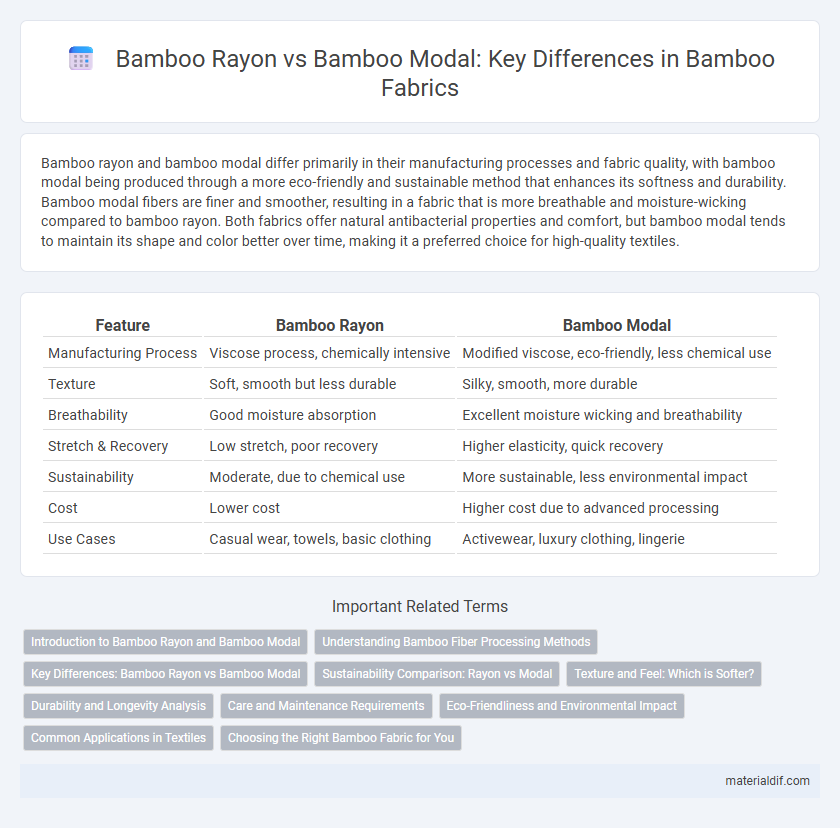Bamboo rayon and bamboo modal differ primarily in their manufacturing processes and fabric quality, with bamboo modal being produced through a more eco-friendly and sustainable method that enhances its softness and durability. Bamboo modal fibers are finer and smoother, resulting in a fabric that is more breathable and moisture-wicking compared to bamboo rayon. Both fabrics offer natural antibacterial properties and comfort, but bamboo modal tends to maintain its shape and color better over time, making it a preferred choice for high-quality textiles.
Table of Comparison
| Feature | Bamboo Rayon | Bamboo Modal |
|---|---|---|
| Manufacturing Process | Viscose process, chemically intensive | Modified viscose, eco-friendly, less chemical use |
| Texture | Soft, smooth but less durable | Silky, smooth, more durable |
| Breathability | Good moisture absorption | Excellent moisture wicking and breathability |
| Stretch & Recovery | Low stretch, poor recovery | Higher elasticity, quick recovery |
| Sustainability | Moderate, due to chemical use | More sustainable, less environmental impact |
| Cost | Lower cost | Higher cost due to advanced processing |
| Use Cases | Casual wear, towels, basic clothing | Activewear, luxury clothing, lingerie |
Introduction to Bamboo Rayon and Bamboo Modal
Bamboo rayon is a regenerated cellulose fiber made from bamboo pulp, known for its softness, breathability, and moisture-wicking properties, making it popular in textiles and clothing. Bamboo modal undergoes a more advanced chemical process, resulting in a fiber with enhanced durability, higher tensile strength, and improved resistance to shrinking and pilling compared to bamboo rayon. Both fabrics offer eco-friendly alternatives to conventional fibers but differ in performance and fabric quality due to their distinct manufacturing methods.
Understanding Bamboo Fiber Processing Methods
Bamboo rayon and bamboo modal are both derived from bamboo fibers but differ in their chemical processing techniques, impacting fabric quality and environmental footprint. Bamboo rayon undergoes a more intensive chemical treatment involving strong solvents like sodium hydroxide and carbon disulfide, which can lead to higher environmental pollution. Bamboo modal uses a gentler, eco-friendlier process with lower chemical usage and produces a fabric known for increased softness, durability, and breathability, ideal for sustainable textile applications.
Key Differences: Bamboo Rayon vs Bamboo Modal
Bamboo rayon is produced through a chemical-intensive process called viscose, resulting in a softer but less durable fabric, while bamboo modal undergoes a more eco-friendly process with higher tensile strength, making it more resilient and longer-lasting. Bamboo modal offers superior moisture-wicking properties and breathability compared to bamboo rayon, enhancing comfort in activewear and daily garments. Both fabrics are derived from bamboo cellulose, but bamboo modal's advanced processing preserves more natural fibers, contributing to its smoother texture and enhanced color retention.
Sustainability Comparison: Rayon vs Modal
Bamboo rayon and bamboo modal both originate from bamboo pulp, but bamboo modal undergoes a more eco-friendly chemical process that reduces environmental toxins and water usage. Bamboo modal fibers offer greater durability and biodegradability, supporting longer garment life cycles and less ecological impact compared to traditional rayon. The sustainability advantage of bamboo modal lies in its closed-loop production system, which recycles solvents and minimizes chemical waste, enhancing overall environmental performance.
Texture and Feel: Which is Softer?
Bamboo modal is generally softer than bamboo rayon due to a more refined spinning process that creates smoother, finer fibers resulting in a silky, luxurious texture. Bamboo rayon tends to have a slightly coarser feel with a bit more stiffness, making bamboo modal preferred for garments requiring an ultra-soft touch. Both fabrics offer breathability and moisture-wicking properties, but bamboo modal excels in softness and drape.
Durability and Longevity Analysis
Bamboo rayon and bamboo modal differ significantly in durability and longevity due to their processing methods. Bamboo modal undergoes a more advanced treatment that enhances fiber strength, resulting in garments that maintain shape and softness after multiple washes. In contrast, bamboo rayon is more prone to fiber weakening and pilling over time, leading to reduced durability in everyday use.
Care and Maintenance Requirements
Bamboo rayon requires gentle machine washing in cold water and air drying to maintain its softness and prevent shrinking, while avoiding bleach and high heat to preserve fabric integrity. Bamboo modal offers enhanced durability with better resistance to pilling and color fading, allowing for regular machine washing on a gentle cycle and low heat tumble drying. Both fabrics benefit from using mild detergents and avoiding fabric softeners to extend garment lifespan and uphold their eco-friendly properties.
Eco-Friendliness and Environmental Impact
Bamboo rayon production involves heavy chemical processing, generating significant environmental pollutants, while bamboo modal utilizes a more eco-friendly closed-loop process that recycles solvents and reduces emissions. Bamboo modal's lower water consumption and energy efficiency contribute to its reduced ecological footprint compared to traditional bamboo rayon. Choosing bamboo modal supports sustainable manufacturing practices and minimizes deforestation and chemical waste in textile production.
Common Applications in Textiles
Bamboo rayon and bamboo modal are both widely used in textile manufacturing, with bamboo rayon commonly found in soft, breathable clothing such as t-shirts, underwear, and baby garments due to its moisture-wicking properties. Bamboo modal, known for its enhanced durability and smoother texture, is often used in luxury and performance fabrics like activewear, loungewear, and high-quality bed linens. Both fibers leverage bamboo's natural antimicrobial qualities, making them popular choices for eco-friendly and comfortable textile products.
Choosing the Right Bamboo Fabric for You
Bamboo rayon is a versatile fabric made from chemically processed bamboo fibers, offering softness and breathability ideal for everyday wear. Bamboo modal, a higher-end option, undergoes a more refined production method that results in a smoother, stronger, and more moisture-wicking textile perfect for activewear and luxury garments. Selecting between bamboo rayon and bamboo modal depends on your priorities for durability, comfort, and environmental impact.
bamboo rayon vs bamboo modal Infographic

 materialdif.com
materialdif.com